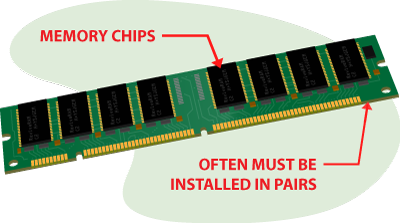-
-
products
-
resources
-
support
-
company
-
How to Buy RAM for your PC
By Steve Horton February 07, 20117, memory, ram, SIMM, virtual memory, vista, windows, xp1 Comment Welcome to a series of articles about your PC and why it might not be running as swiftly as you’d like. Even the newest PC, especially an all-in-one model like a Dell or an HP, can have what are called bottlenecks, named for the narrow neck of a bottle. These key areas of your computer are the most susceptible to causing performance problems, and we feel that you should be made aware of them and how to prevent them from slowing down you PC. These articles will help you for when you are buying a new computer and when you are optimizing one that you already own.Today’s Question: How to Buy Ram for your PC?
Welcome to a series of articles about your PC and why it might not be running as swiftly as you’d like. Even the newest PC, especially an all-in-one model like a Dell or an HP, can have what are called bottlenecks, named for the narrow neck of a bottle. These key areas of your computer are the most susceptible to causing performance problems, and we feel that you should be made aware of them and how to prevent them from slowing down you PC. These articles will help you for when you are buying a new computer and when you are optimizing one that you already own.Today’s Question: How to Buy Ram for your PC?
RAM, 32-bit Windows, and 64-bit WindowsCurrently, both mass storage (hard drives) and RAM (memory) have been selling at historically low prices. When deciding how much RAM your new PC should have, or how much to put in it if you’re savvy enough to do so, the easy answer is “as much as it can handle”, as you won’t be spending a whole lot more to double or even triple the amount of RAM these days. But that’s the easy answer and not the most complete one.
What is RAM?
RAM is another name for the memory in your PC. When you buy a new PC and it comes with 2 GB or 4 GB of RAM, this means the memory that your system moves data in and out of. More is better. RAM is often confused with the storage on your PC, a much larger amount (such as 500 GB) represented by your hard drive, where files are stored permanently.
Hitting the RAM Limit
When you have too little RAM in your PC and it fills up, your system will start using space on your much slower hard drive as memory, a process called virtual memory. Too much of this will slow your computer way down, so you want to make sure Windows doesn’t have to do this by having lots of RAM available.Older System Limitations
PCs just a few years old, especially all-in-one system from companies like Dell, Gateway and HP, often are severely limited in how much maximum RAM can be put in. Often, your system may only be able to handle 2 GB, which is barely enough to run Windows 7 and a few applications. (Windows XP has a much smaller memory footprint and is a far wiser choice for systems with RAM limitations.) Also, laptop or notebook PCs, especially netbooks, are quite often limited in their ability to upgrade RAM. Some even go so far as to make it difficult, if not impossible, to upgrade the RAM. I had a five year old Dell laptop until a few months ago. Although you could easily reach one of the RAM modules (called SIMMs) through a panel on the bottom, the other SIMM required me to pry off the keyboard to reach it in order to upgrade the amount of RAM in that slot. Not user-friendly in the least!What kind of RAM?
One of the most esoteric things about your PC is what kind and type of RAM it’s supposed to have. Although it is common to refer to the amount of RAM that a computer has installed, there really are no real standards out there.There have been dozens of memory module types and speeds released, so upgrading your RAM is not as easy as it seems — you need to buy the right speed and type of RAM. Additionally, sometimes RAM modules have to be installed in pairs. To help you find out how many RAM slots you have and what type of RAM you have check out the database and/or free scanning tool at crucial.com. Once you know how many slots are filled, what kind of RAM you need, and so on, then purchasing the right modules is easy. But you may need help to install them. Your owner’s manual will often include a RAM installation guide, or get someone computer savvy to help you. In the case of a desktop PC, it involves a screwdriver, opening up your case, and likely moving some things out of the way to get to your SIMM slots. Actually taking out and/or putting in the modules is a piece of cake, though.After upgrading the amount of RAM you have installed and rebooting, you should notice a significant increase in your PCs performance (depending on how much you have added) as your computer is able to process more information at any point in time.
The 32-Bit vs 64-Bit Windows Factor
Unfortunately, 32-bit Windows operating systems have a severe limitation that there’s no way around. They can only make use of up to 3.5 GB of RAM, regardless of how much RAM your system actually has. The rest is dormant. More and more new PCs, such as the Toshiba laptop I’m writing this article on, are preinstalled with 64-bit Windows 7, which, like 64-bit Vista or XP, can makes use of all of the RAM that you have installed within your PC (Windows 7 can support up to 128 GB of RAM!). This makes a big difference when playing modern games, using Photoshop, creating 3D graphics or other hardware-intensive activities. In these cases, having a 64-bit operating system, and as much RAM as the PC can handle, is a must. It also helps in these cases that the application itself (such as Photoshop) is 64-bit native. You can tell this by which directory the app installs itself into. If it lands in Program Files, it’s a 64-bit app; if it lands in Program Files (x86), it’s a 32-bit app.Sometimes, finding the 64-bit version of an application can be frustrating. For example, until recently, if you were on a 64-bit computer and you downloaded iTunes, it was not until you had completed the download and begun installing it that the application told you that you needed to download the 64 bit version. As 64-bit computers are becoming more common, software producers are creating applications that support both 32- and 64-bit version of Windows.
If you have no idea what bitrate your operating system is, Windows Vista and 7 can tell you easily. Click on the Start menu -> Control Panel -> System. Look under System Type for the answer. In Windows XP, it’s quite a bit more convoluted: Click Start, then Run. Type sysdm.cpl, then click OK, then click the General tab. Under System, it’ll tell you if you have 32-bit or 64-bit Windows. Back in the XP era, 32 bit was far more common than now, so odds are, if you’ve got XP, you have 32 bit.
Bottom Line
RAM is cheap and makes a big difference in computer speed! Feel free to upgrade all the way up to 3 or 4 GB of RAM if you’ve got a 32 bit operating system, as long as your PC can handle that much. You’ll notice a tremendous speed difference through all aspects of your system. With memory as cheap as it is now, there’s no reason not to do this. Don’t go above 4 GB unless you have a 64-bit operating system, as your system will be unable to use it and you would have wasted your money. And always get the best RAM your system is capable of handling, and buy RAM in pairs of modules if you can; you’ll eke out better performance from each pair of modules that’s of the same type and speed.Was this post helpful?YesNoFree Driver Updates
Update your drivers in less than 2 minutes to enjoy better PC performance - Free.
Free Driver Updates
Update your drivers in less than 2 minutes to enjoy better
PC performance - Free.
Didn't find your answer?Ask a question to our community of experts from around the world and receive an answer in no time at all.most relevant recent articles Pin It on Pinterest
